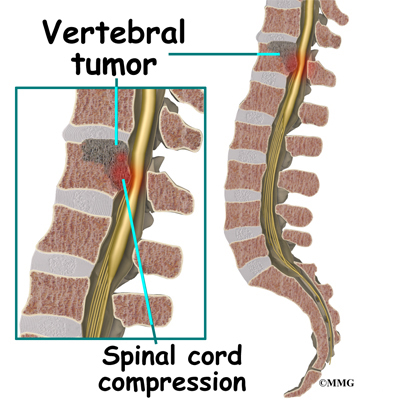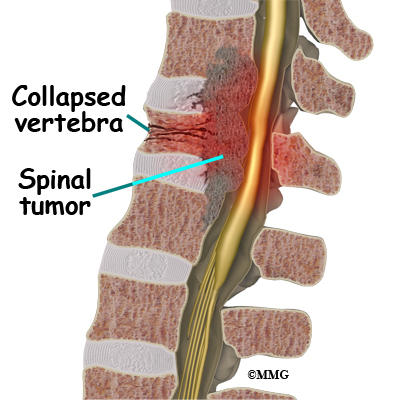Author: ab robinson
A spinal cord tumor is a benign or cancerous growth in the spinal cord, between the membranes covering the spinal cord, or in the spinal canal. A tumor in this location can compress the spinal cord or its nerve roots; therefore, even a noncancerous growth can be disabling unless properly treated. Spinal cord parenchyma consists of both gray (neurons and supporting glial cells) and white matter (axonal) and tracts that transmit impulses between the brain and body. These tracts, or circuits, control posture, movement, sensation, and autonomic system function, including bowel and bladder and sexual function.
Spinal cord tumors are abnormal growths of tissue found inside the skull or the bony spinal column, which are the primary components of the central nervous system (CNS).
 Benign tumors are noncancerous, and malignant tumors are cancerous. The CNS is housed within rigid, bony quarters (i.e., the skull and spinal column), so any abnormal growth, whether benign or malignant, can place pressure on sensitive tissues and impair function. Tumors that originate in the brain or spinal cord are called primary tumors. Most primary tumors are caused by out-of-control growth among cells that surround and support neurons.
Benign tumors are noncancerous, and malignant tumors are cancerous. The CNS is housed within rigid, bony quarters (i.e., the skull and spinal column), so any abnormal growth, whether benign or malignant, can place pressure on sensitive tissues and impair function. Tumors that originate in the brain or spinal cord are called primary tumors. Most primary tumors are caused by out-of-control growth among cells that surround and support neurons.Spinal cord tumors - and most cancers - remain a mystery. Scientists do not know exactly why and how cells in the nervous system or elsewhere in the body lose their normal identity as nerve, blood, skin, or other cell types and grow uncontrollably. Research scientists are looking for clues to this process with the goals of learning why and how cancer begins and developing new tools to stop it. Some of the possible causes under investigation include viruses, defective genes, and chemicals.
Spinal cord tumors are much less common than brain tumors. Spinal cord tumors may be primary or secondary. Primary spinal cord tumors originate in the cells within or next to the spinal cord. Only about 10% of primary spinal cord tumors originate in the cells within the spinal cord. The rest originate in cells next to the spinal cord. For example, some tumors develop on spinal nerve roots—the parts of spinal nerves that emerge from the spinal cord (see Biology of the Nervous System: How the Spine Is Organized). Primary spinal cord tumors may be cancerous or no cancerous.
Most spinal cord cancers are metastatic or secondary cancers, meaning that they arise from cancers that have spread to the spinal cord. Cancers that may spread to the spine include lung, breast, prostate, head and neck, gynecologic, gastrointestinal, thyroid, melanoma, renal cell carcinoma and others.
Spinal cord tumors are abnormal growths of tissue found in or near the spinal cord. Because the spinal cord is housed within a rigid, bony structure (the spinal column), any abnormal growth can exert pressure
 on sensitive tissues and impair function. Also, any tumor located near sensitive spinal cord nerves can cause pain and weakness. Spinal cord tumors affect people of all ages, but are most commonly found in young to middle-aged adults.
on sensitive tissues and impair function. Also, any tumor located near sensitive spinal cord nerves can cause pain and weakness. Spinal cord tumors affect people of all ages, but are most commonly found in young to middle-aged adults.Structurally, the spinal cord is a double-layered tube: The butterfly-shaped inner layer (gray matter) contains nerve cells, supporting cells called glia and blood vessels. The outer layer is primarily white matter — nerve fibers (axons) that relay sensory information such as pain and temperature from your body to your brain and conduct motor impulses from your brain to your muscles, organs and glands. The axons are bundled into 31 pairs of spinal nerves, with one sensory nerve root and one motor nerve root in each pair. The paired nerves extend out from the spinal cord between each vertebra.
Source: http://www.articlesbase.com/


